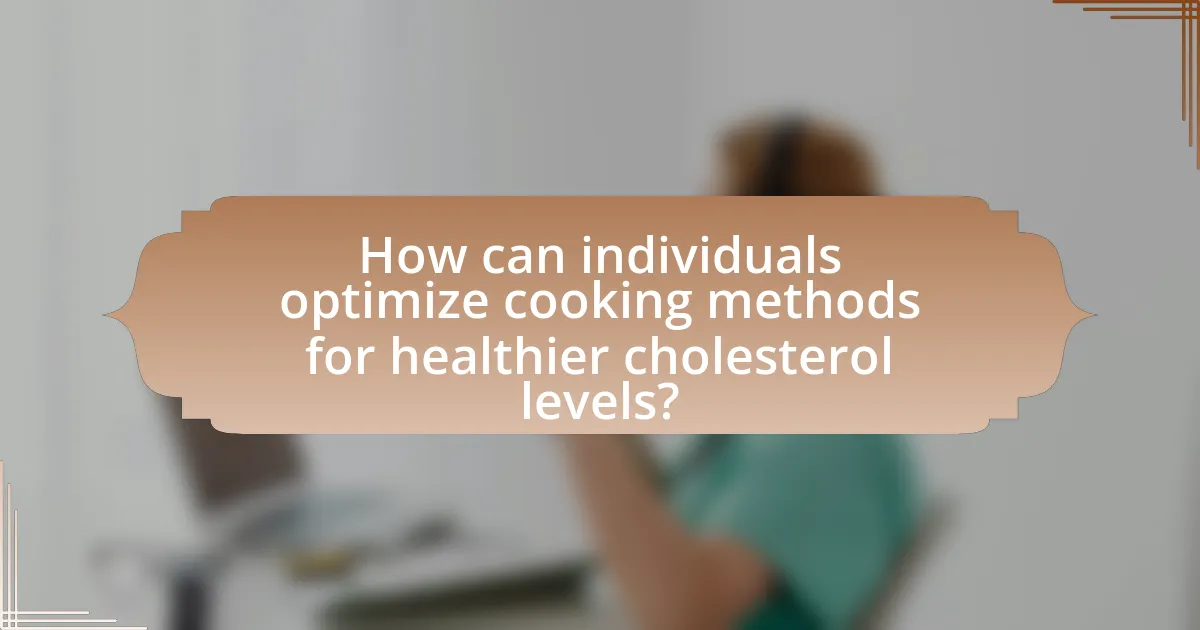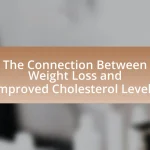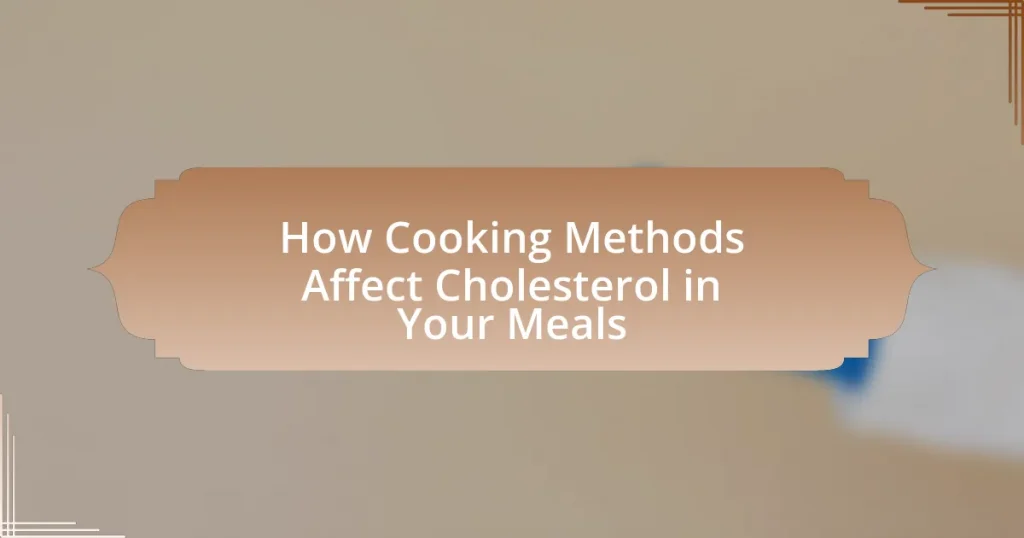Cooking methods play a crucial role in influencing cholesterol levels in meals by altering the fat content and composition of food. Techniques such as frying can increase saturated fat and LDL cholesterol, while healthier methods like steaming, grilling, and baking help preserve natural fats and lower cholesterol intake. The article explores various cooking methods, their impact on cholesterol absorption, and the importance of ingredient choices, emphasizing how adopting healthier cooking practices can support better cardiovascular health and manage cholesterol levels effectively. Additionally, it highlights the significance of temperature, cooking duration, and the selection of oils and fats in optimizing meals for lower cholesterol.

How do cooking methods influence cholesterol levels in meals?
Cooking methods significantly influence cholesterol levels in meals by altering the fat content and composition of the food. For instance, frying foods typically increases their saturated fat content, which can raise LDL cholesterol levels in the body. In contrast, methods such as steaming or grilling tend to preserve the natural fat content without adding extra saturated fats, thereby having a neutral or beneficial effect on cholesterol levels. Research indicates that diets high in saturated fats can lead to increased cholesterol levels, while those rich in unsaturated fats, often retained through healthier cooking methods, can help lower cholesterol levels.
What are the different cooking methods that affect cholesterol?
Different cooking methods that affect cholesterol include frying, boiling, grilling, and baking. Frying, particularly deep-frying, can increase the cholesterol content of foods due to the absorption of unhealthy fats. Boiling typically does not add fats but may not significantly reduce cholesterol levels in foods. Grilling can help reduce fat content as excess fat drips away, while baking is generally a healthier method that can maintain lower cholesterol levels in foods. Studies indicate that cooking methods that involve added fats, such as frying, can lead to higher cholesterol levels in the final dish compared to methods that use little to no added fats.
How does frying impact cholesterol content in food?
Frying food generally increases its cholesterol content due to the absorption of fats during the cooking process. When food is fried, it often absorbs the cooking oil, which can be high in saturated fats and trans fats, both of which can raise cholesterol levels in the body. For example, studies have shown that frying foods like potatoes or meats can lead to a significant increase in their total fat content, which correlates with higher cholesterol levels. Additionally, the type of oil used for frying can further influence the cholesterol outcome; oils high in saturated fats, such as palm oil, can contribute more to increased cholesterol levels compared to oils with healthier fat profiles, like olive oil.
What effects does boiling have on cholesterol levels?
Boiling does not significantly alter cholesterol levels in foods. Research indicates that boiling primarily affects the water-soluble nutrients in food rather than fat content, which includes cholesterol. For instance, a study published in the Journal of Food Science found that boiling vegetables led to a loss of certain vitamins but did not impact the cholesterol levels present in the food. Therefore, boiling is a cooking method that maintains the cholesterol content of foods while potentially reducing other nutrients.
How does grilling alter cholesterol in meals?
Grilling can reduce the cholesterol content in meals by allowing fat to drip away from the food during the cooking process. This method of cooking typically involves high temperatures that can break down some of the saturated fats present in meats, which are known to contribute to higher cholesterol levels. Research indicates that grilling can lead to a decrease in total fat content, which correlates with lower cholesterol intake. For example, a study published in the Journal of Food Science found that grilling chicken resulted in a significant reduction of fat compared to frying, thus potentially lowering the cholesterol levels in the final meal.
Why is it important to consider cooking methods for cholesterol management?
Cooking methods are crucial for cholesterol management because they directly influence the fat content and nutritional quality of food. For instance, methods like boiling or steaming retain more nutrients and reduce the need for added fats, while frying can significantly increase unhealthy fat intake. Research indicates that diets high in saturated and trans fats can elevate LDL cholesterol levels, which is linked to heart disease. Therefore, selecting healthier cooking techniques can help maintain lower cholesterol levels and promote overall cardiovascular health.
What role does cholesterol play in overall health?
Cholesterol plays a crucial role in overall health by contributing to the formation of cell membranes, hormones, and vitamin D. It is essential for various bodily functions, including the synthesis of steroid hormones like cortisol and sex hormones, as well as aiding in the absorption of fat-soluble vitamins A, D, E, and K. The body requires a balance of cholesterol, with high-density lipoprotein (HDL) being beneficial for heart health by transporting cholesterol away from arteries, while low-density lipoprotein (LDL) can contribute to plaque buildup in arteries when present in excess. According to the American Heart Association, maintaining healthy cholesterol levels is vital for reducing the risk of cardiovascular diseases, highlighting the importance of monitoring and managing cholesterol intake through diet and lifestyle choices.
How can cooking methods help in reducing dietary cholesterol?
Cooking methods can help in reducing dietary cholesterol by utilizing techniques that minimize the addition of unhealthy fats and promote healthier ingredient choices. For instance, methods such as steaming, grilling, and baking allow food to retain its natural flavors without the need for excessive oils or fats, which can contribute to higher cholesterol levels. Research indicates that frying foods can significantly increase their fat content, while methods that involve less fat can lead to lower overall cholesterol intake. Additionally, cooking methods that incorporate more vegetables and whole grains can further enhance the nutritional profile of meals, thereby supporting heart health and reducing dietary cholesterol.

What specific factors in cooking methods affect cholesterol absorption?
Cooking methods significantly influence cholesterol absorption, primarily through the type of fat used, cooking temperature, and duration. For instance, frying foods in saturated fats can increase cholesterol absorption compared to steaming or boiling, which typically use little to no added fat. High temperatures can also lead to the formation of harmful compounds that may enhance cholesterol absorption. Additionally, prolonged cooking times can break down food structures, potentially increasing the bioavailability of cholesterol. Studies indicate that methods like grilling or broiling, which allow fat to drip away, may result in lower cholesterol absorption compared to methods that retain fat.
How do temperature and time influence cholesterol levels during cooking?
Temperature and time significantly influence cholesterol levels during cooking by affecting the stability and breakdown of cholesterol in food. Higher cooking temperatures, such as frying or grilling, can lead to the oxidation of cholesterol, potentially increasing harmful compounds. For instance, studies have shown that cooking meat at high temperatures for extended periods can elevate the formation of oxidized cholesterol, which is linked to cardiovascular diseases. Conversely, lower temperatures and shorter cooking times, such as steaming or poaching, tend to preserve cholesterol levels more effectively, minimizing the risk of oxidation.
What is the effect of high temperatures on cholesterol?
High temperatures can lead to the oxidation of cholesterol, which may result in the formation of harmful compounds. When cholesterol is exposed to high heat during cooking, such as frying or grilling, it can undergo chemical changes that increase the risk of cardiovascular diseases. Research indicates that heating oils containing cholesterol can produce oxidized cholesterol, which has been linked to inflammation and atherosclerosis. Therefore, cooking methods that involve high temperatures can negatively impact cholesterol quality and overall health.
How does cooking duration impact cholesterol content?
Cooking duration can significantly impact cholesterol content in food, particularly in animal products. Prolonged cooking times can lead to the breakdown of cholesterol, resulting in lower levels in the final dish. For instance, studies have shown that cooking meat at high temperatures for extended periods can reduce its cholesterol content by up to 20%. This reduction occurs due to the oxidation of cholesterol and the leaching of fat-soluble compounds into cooking liquids. Therefore, the duration of cooking directly influences the cholesterol levels in cooked foods, making it an important factor in dietary management.
What ingredients can alter the cholesterol effects of cooking methods?
Certain ingredients can significantly alter the cholesterol effects of cooking methods, particularly those high in unsaturated fats, fiber, and antioxidants. For example, using olive oil instead of butter can reduce the overall cholesterol content in a dish, as olive oil is rich in monounsaturated fats that help lower LDL cholesterol levels. Additionally, incorporating ingredients like avocados, nuts, and fatty fish, which contain omega-3 fatty acids, can further mitigate the negative cholesterol effects associated with cooking methods such as frying. Research indicates that diets rich in these ingredients can lead to improved lipid profiles, demonstrating their effectiveness in altering cholesterol outcomes during cooking.
How do oils and fats used in cooking affect cholesterol levels?
Oils and fats used in cooking can significantly affect cholesterol levels, primarily by influencing the balance of LDL (low-density lipoprotein) and HDL (high-density lipoprotein) cholesterol in the body. Saturated fats, commonly found in animal products and certain oils like palm and coconut oil, tend to raise LDL cholesterol levels, which is associated with an increased risk of heart disease. Conversely, unsaturated fats, such as those found in olive oil, can help lower LDL cholesterol and raise HDL cholesterol, promoting better heart health. Research published in the American Journal of Clinical Nutrition indicates that replacing saturated fats with unsaturated fats can lead to a reduction in cardiovascular disease risk.
What role do seasonings and marinades play in cholesterol management?
Seasonings and marinades can play a significant role in cholesterol management by enhancing flavor without adding unhealthy fats or sodium. They often contain herbs and spices, such as garlic, turmeric, and ginger, which have been shown to possess cholesterol-lowering properties. For instance, garlic has been linked to reduced total cholesterol and LDL cholesterol levels in various studies, including a meta-analysis published in the Journal of Nutrition. Additionally, using vinegar-based marinades can help reduce the need for saturated fats in cooking, further supporting heart health.

How can individuals optimize cooking methods for healthier cholesterol levels?
Individuals can optimize cooking methods for healthier cholesterol levels by using techniques such as steaming, grilling, and baking instead of frying. These methods reduce the need for added fats, which can contribute to higher cholesterol levels. For instance, a study published in the American Journal of Clinical Nutrition found that individuals who consumed grilled or baked foods had lower LDL cholesterol levels compared to those who frequently ate fried foods. Additionally, incorporating more plant-based ingredients and using healthy oils, like olive oil, can further support heart health by providing beneficial fats and nutrients.
What are some best practices for cooking to lower cholesterol?
To lower cholesterol, best practices for cooking include using healthy fats, opting for lean proteins, and incorporating plenty of fruits and vegetables. Cooking with unsaturated fats, such as olive oil or avocado oil, instead of saturated fats like butter can significantly reduce cholesterol levels. Choosing lean meats, such as chicken or fish, over fatty cuts of beef or pork helps minimize saturated fat intake. Additionally, incorporating a variety of fruits and vegetables provides essential nutrients and fiber, which can help lower cholesterol. Studies show that diets rich in fruits, vegetables, and healthy fats can lead to improved cholesterol profiles and overall heart health.
How can steaming be used as a healthier cooking method?
Steaming can be used as a healthier cooking method because it preserves nutrients and reduces the need for added fats. When food is steamed, it retains more vitamins and minerals compared to boiling or frying, which can leach nutrients into water or require oils that increase calorie content. Research indicates that steaming vegetables can retain up to 90% of their nutrients, while boiling may result in a loss of 50% or more. This method also helps maintain the natural flavors and textures of food, making it a preferred choice for health-conscious cooking.
What alternatives to frying can be used to reduce cholesterol intake?
Steaming, baking, grilling, and sautéing are effective alternatives to frying that can significantly reduce cholesterol intake. Steaming preserves nutrients and avoids added fats, while baking uses dry heat to cook food without the need for oil. Grilling allows excess fat to drip away from the food, and sautéing uses minimal oil, often incorporating healthy options like olive oil. Research indicates that cooking methods that require less fat can lead to lower saturated fat consumption, which is linked to reduced cholesterol levels. For instance, a study published in the Journal of Nutrition found that individuals who adopted cooking methods like steaming and grilling experienced a notable decrease in LDL cholesterol levels compared to those who frequently fried their food.
What common mistakes should be avoided when cooking for cholesterol management?
Common mistakes to avoid when cooking for cholesterol management include using unhealthy fats, neglecting fiber-rich ingredients, and overcooking foods. Using saturated and trans fats, such as butter and certain oils, can raise cholesterol levels, while opting for healthier fats like olive oil can help manage cholesterol. Additionally, failing to incorporate fiber-rich foods, such as whole grains, fruits, and vegetables, limits the ability to lower cholesterol effectively, as soluble fiber helps reduce LDL cholesterol. Overcooking can also diminish the nutritional value of foods, leading to a loss of beneficial compounds that support heart health.
How can overcooking affect cholesterol levels in meals?
Overcooking can increase cholesterol levels in meals by causing the breakdown of fats and the formation of harmful compounds. When foods, particularly meats, are overcooked, they can undergo oxidation, which leads to the creation of trans fats. Trans fats are known to raise low-density lipoprotein (LDL) cholesterol, commonly referred to as “bad” cholesterol, while lowering high-density lipoprotein (HDL) cholesterol, or “good” cholesterol. Studies have shown that cooking methods that involve high temperatures for extended periods, such as frying or grilling, can exacerbate this effect, leading to a higher risk of cardiovascular diseases associated with elevated cholesterol levels.
What should be considered when choosing cooking oils for health?
When choosing cooking oils for health, it is essential to consider the oil’s fatty acid composition, smoke point, and nutritional benefits. Oils high in unsaturated fats, such as olive oil and avocado oil, are beneficial for heart health due to their ability to lower bad cholesterol levels. The smoke point is crucial because oils that exceed their smoke point can produce harmful compounds; for example, oils like canola and grapeseed have higher smoke points suitable for high-heat cooking. Additionally, oils rich in omega-3 fatty acids, such as flaxseed oil, provide anti-inflammatory benefits. Research indicates that diets incorporating healthy oils can reduce the risk of cardiovascular diseases, supporting the importance of selecting the right cooking oils for overall health.










